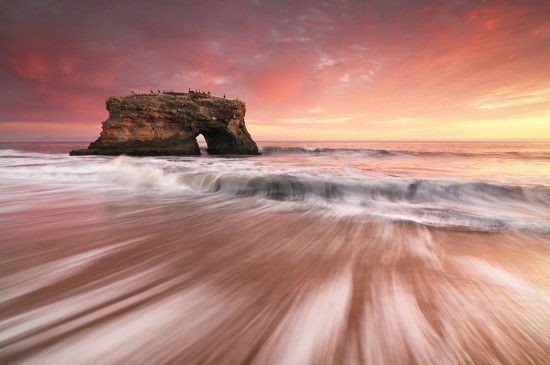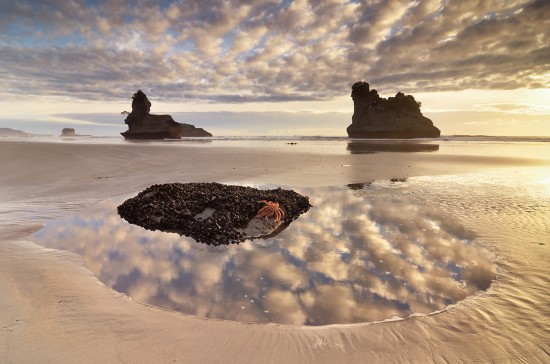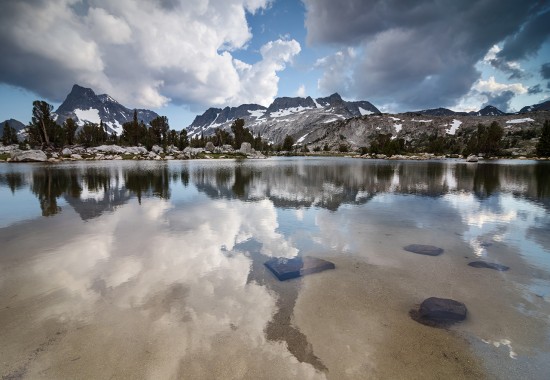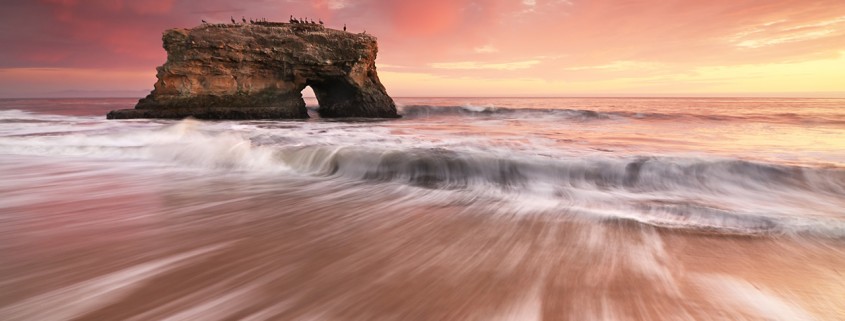To Swap or Not to Swap…
Photoshop has always been a hot-button issue in the world of photography. But recently a specific topic has been getting a lot of attention when it comes to landscape photography post-processing… the topic of swapping skies. In other words, switching out an image’s boring sky for one that makes your viewer say “Va-va-voom!” There have been discussions popping up on Facebook and 500px, text messages winging through the data sphere, and (gasp!) even conversations happening face-to-face.
Some photographers are all for it, some are diametrically opposed to it, and a few couldn’t care less one way or the other. In any case, a common conclusion from these discussions is that “art is art” and how one photographer chooses to create an image is solely that individual’s business. But in my view, such a laissez-faire approach isn’t sufficient because, while art may be art, all art is not photography. Meaning that do whatever you want doesn’t apply here. After all, brushing a bunch of acrylic paint onto a metal sculpture and calling it pottery doesn’t make it pottery. I believe that, as photographers, we have an obligation to stand on one side of the issue or the other and decide… is this photography?
I’ll start. I’m one of the curmudgeons who staunchly believes that sky replacement has absolutely no place in landscape photography. I’m not saying it doesn’t take skill to pull off seamlessly or even that it doesn’t make an image look better. But it does take an image from the realm of photography and plops squarely it into that of graphic design or digital art. Semantics and definitions aside, I am actually far more interested in the concepts represented by landscape photography. And from that standpoint, I believe that swapping skies weakens the art as a whole and, more importantly, cheats you out of one of the most magical parts of photography: the profound experience.
Don’t worry. I’m not going to sit here all day and lecture you on the ethics of art. You want to replace your skies? I’m not going to stop you. I mean, it’s not like you’re recruiting child soldiers or something. But I do think there are a few vitally important things to consider before you head down that road.
I just don’t think it’s necessary. The world produces so many beautiful moments that, to me, it seems superfluous to invent one. If conditions don’t line up for the shot you want, get out there and try again.

A real scene that actually occurred. All it took to capture it was persistence in visiting this location.
Trust me… I fully understand the temptation to replace a sky. How many times have you been out shooting when the conditions were almost spectacular? Or maybe you took a shot in a place that you’ll never visit again and you’re disappointed that conditions didn’t live up to your expectations. It’s happened to me more times than I can count. And, even if you captured a nice photo, if only the color had just reached all the way across the frame or if the clouds had just turned red instead of staying gray, then the photo would be that much better. So what’s the harm in using digital technology to make it so?
Thus goes an argument of the pro swappers. A better sky makes the viewer more emotionally engaged with the image and gives the image more impact. I might actually agree with this if I believed that a photo is simply (and superficially) pixels on a screen. But it’s not. A fantastic photo is a representation of a real thing… what Henri Cartier-Bresson called The Decisive Moment. That perfect confluence of subject, timing, composition, light, and technique that captures the magic, the power, or the statement of a single slice of time.
To me, that is what gives a good landscape photo impact… it captures the magic of a real moment and makes a statement about the planet on which we live. So how can a photo have any impact at all if the moment it depicts never actually existed? In other words, if the power of a photo lies in it being a representation of reality, that power collapses when you start to manufacture the reality behind it. You might as well also add in a huge full moon or even a second moon. And why not add a rainbow while you’re at it? Or, even better, the silhouette of a howling wolf or maybe a unicorn? It might be an image with lots of WOW! power, but it certainly has no credibility as an impactful photo.

A moment of beauty which to me is more powerful because this is what I actually saw while standing on the beach. To me it says Look how beautiful the Earth can be. Not Look how beautiful I wish the Earth was.
More importantly than destroying the impact of your photo, I believe that sky replacement cheats you out of one of the most profound parts of landscape photography… experiencing a unique moment of Earth’s spectacular beauty. Those perfect moments are rare, and they should be! That’s what makes them special. When every image you create is epic, you diminish the actual life experiences that truly are.

The power of this photo for me stems from the experience of watching those actual clouds billow and blossom over those actual mountains and reflect in this actual tarn. An experience of profound beauty and joy, one which I wouldn’t want to diminish by having merely invented it digitally.
Replacing a sky also cheats you out of the satisfaction of capturing one of those rare moments. Capturing a successful landscape photograph often requires discipline, persistence, perseverance, dedication, hard work, sweat, planning, patience, creativity, a good eye, and technical skill. When you excuse yourself from developing those qualities, you’re not actually earning the images you create. To me, it’s a hollow victory to create a spectacular image via Photoshop. I’d much rather know that when Mother Nature brought her best, I was able to bring my best as well to capture one of those moments. If that means capturing hundreds of mediocre photos for every truly spectacular one, I’m more than willing to pay that price.
What do you think? Does sky replacement weaken the art of photography or do I just sound like an old fart from the dark ages? Let me know in the comments.
Full Disclosure: Some of you may note that I have a Photoshop tutorial where I do replace the sky in one of my photos. I did this, not for the purpose of replacing the sky, but rather because it’s an excellent way to teach the various selection tools available in Photoshop. Also, some of my night photos are combinations of two exposures: one for the sky and one for the foreground. This is done to overcome the technical limitations of the camera only; and in every case the stars, Milky Way, composition, and other photographic elements are genuine to those moments.






This is a really interesting article and discussion I’m visiting a year late, thanks to the power of The Google. Which, I suppose, is an interesting parallel for what we’re talking about, in non-real time.
I’m researching real-estate photography as a career. I also have a photojournalism background where you can’t/don’t alter photos for purely aesthetic reasons. My gut says you CANNOT drop a different sky into the foreground you want. But you all bring up really great parallel points / analogies. When is HDR or bracketing too much? (I disdain “extreme” HDR that looks surreal, but I can’t help but admire the beauty … a love/hate relationship.) When is a wide-angle, a telephoto, a tilt-shift, a filter, a long exposure,a time-lapse, ANYTHING we can’t see with our eyes begin to cross ethical boundaries?
I know where I side with respect to being a “photographer” … physical tools that help capture what a human can see are ok. Once that file is dragged onto a computer and you start adding or subtracting something that wasn’t there, it becomes ART not photography. We used to call it a “photo-illustration.”
That works fine as an ethical hobbyist, but I wonder what it means to a working professional trying to satisfy clients without selling out the industry, or diving into an endless cycle of one-upsmanship over competing professionals. I think we’ve all got to work to sustain the credibility of the profession. And yet, we all have to recognize that our clients need to sell homes (or whatever the equivalent in your sub-industry).
So the question / talking point here is … does the calculus change when you’re photographing on behalf of a client? Do you then adopt their ethics, or stand by your own at the risk of losing the client? In the case of something as ephemeral as real estate, does it even matter?
I think the answer to your question will vary by the outlook of the photographers….and to some extent your client.
Moonlit Dreams
About 10 years ago one of the major photography magazine wanted to my photo below in their publication. As it happens this photo is an composite image created with one framed exposed for the foreground and other exposed for the moon with a different focal length and merging them together. This was quite acceptable technique in the old film days where you can create an image like this one by exposing the same frame more than once. The editor was stunned that this was a multiple exposed imaged as there are no visual cue to think otherwise. In the end they decided not to publish this photo in the magazine as it was more of an art then a photo. But since then this has been published in other photography magazine where the editors think this is a perfectly acceptable technique as this was done long before digital photography came on scene. :)
Hi Joshua,
You made some pretty compelling arguments there and I find myself agreeing with what you said. I have no problem making composites when the end result is something that could not exist in reality such as a person the height of a coffee mug but for landscape photography I would rather be spending my time outdoors than working in Photoshop. Making the best shot that I can of what is in front of my eyes seems to me to be easier than trying to take a photo whose sky will end up being replaced.
I think it’s pretty easy to plop oneself down on either side of this fence. If we’re going to declare swapping skies off limits, how do we justify 4 minute long exposures, or even 30 second LE’s? How about light painting….or using fisheye lenses? In general, I would tend to lean in the same direction as your general philosophy in this article suggests. But I don’t view it as being a hard & fast ‘rule’ either.
It wouldn’t be that hard to envision a scenario where I’d set up for a sunset shot on Clingmans Dome and 20 minutes prior to sunset I capture the sun just barely peeking out from under a cloud and forming a great little sunburst in the capture. But the cloud cover also leaves the ridges of the fore to mid ground ridges looking rather dull. But I don’t plan to, and actually don’t, move the tripod until well after official sunset…..capturing additional frames every minute or two. And wouldn’t ya know, about 3 minutes prior to the sun’s official disappearance, the cloud cover breaks just enough to allow the sun to just skip across the ridgetops and cast a terrific ribbon of light across them. But of course, the sun is also creating a wicked little hotspot in this latter frame as well.
Would I combine the 2 images described above? I never have, and up until a couple months ago, I would have said no. But as I sit writing this today, I think I would at least consider it.
Scenarios like the above create a pretty fuzzy line with a lot of gray on either side for me. If a 17 minute difference in exposures is ok, why not 2 hr? As long as the lighting ‘works’, and doesn’t go all wonky because of directional changes, I’m not sure if there should be a time differential limitation.
On the other hand, when I see a shot where the foreground clearly suggests a super wide angle was attached to the camera, and yet the moon is just HUGE and filling 2/3 of the frame, then I have no problem declaring the shot ‘digital art’ rather than ‘photography’. It may well be a fantastic piece of 2 dimensional imagery, but I’d be inclined to think of it as digital art using photography as it’s underlying medium, but I wouldn’t call it photography.
At least that’s how I view things this evening. I reserve the right to flip flop every day if someone presents a cogent argument for either side of the fence. :)
Hey RJ,
Interesting thoughts here. I hadn’t considered this from the standpoint of LEs before and it led me down some interesting paths, since you obviously can’t experience a long exposure, so is it real?
I think for me what it comes down to is that I want my photo to be a representation of an actual experience. If a long exposure helps convey the mood I was feeling, or the drama of clouds whipping by overhead, I still consider that a representation of an actual experience. It’s when the experience is manufactured after the fact (a la swapping skies) that I set my feet.
Cheers!
Josh
While I respect your opinion I do not happen to agree with it. Here is a story to explain why I am pro sky swapping. I am not free to travel on a whim so when I get to a special place, I’m usually limited by time. On a recent trip to Death Valley, I spent 5 days photographing some beautiful mornings, however those mornings were cloudless yielding less then dramatic skies. On the last day some beautiful clouds rolled in at sunrise. After photographing the scene I was after, I continued to photograph that beautiful sky to add into the images I had created on previous days. Those skies were in those scenes, just not when I was there. Why does digital photography have to be limited to capturing the moment we are stuck with? We distort space with our lens choices, why can’t we distort time a little too?
Hi Rich,
Thanks for your comment and your thoughts. I think everyone has to decide what the goal of their photography is. For me part of it is to represent a real moment of beauty that I experienced. The photos that come from those moments (as well as the moments themselves) are made more special and more fulfilling by their rarity. Because I don’t view a photo in a vacuum by itself, for me a photo loses its impact when the reality it represents was fabricated, because the essential experience that it is tied to didn’t exist.
Cheers,
Josh
So here’s my dilemma…
I often bracket several different exposures when shooting into the sun results in a big dynamic range which my camera can’t handle in one shot. These bracketed photos are usually only captured milliseconds apart… but sometimes a bit longer when I fiddle to get each exposure just right.
Is the blending together of bracketed images also considered as a sky replacement? Because that is essentially what I’m doing… swapping out an overexposed sky for a better exposed one… possibly captured a few seconds after the foreground shot. If this practice is seen as acceptable by the “I don’t agree with sky-replacements” purists… then what is the longest acceptable delay between taking the foreground image and the sky image? A couple of milliseconds is obviously okay… and a couple of seconds is probably still acceptable… but what about an hour (or more)?
So my dilemma is almost exactly the same as Andrey’s. At what point does the replacement of a sky (which was shot on the same day with the camera in exactly the same position) become unacceptable?
Thanks Josh… for your thought-provoking musings. I can see that you and I are going to be have some very interesting discussions in New Zealand next year!
Hey Paul,
Yes, I am definitely looking forward to many great discussions in New Zealand!
Now this is a fantastic question. I too sometimes blend exposures. And though my intention is merely to overcome the technical limitations of the camera, it does raise the question of how far apart in time the images can be before you get yourself into some photo-ethical quicksand.
For me, I personally tend to think in subjective moments, rather than in objective seconds. In other words, has the emotion and feel of the moment changed from shot to shot? If not, and your goal is inherently to capture those feeling and emotions, then I don’t think it makes a difference if the shots are a second, a minute, or 5 minutes apart. But if in between your two exposures the feel of the scene has changed noticeably, meaning that your latter shots convey something different than your former shots, that’s where I think you get into “sky replacement” territory.
Cheers,
J
Hi Andrey,
Now that is a great question and really exposes the gray area in this whole mess. I can’t say unequivocally what’s right and wrong in a situation like this; I think every photographer needs to decide for him or herself what fits in their own personal photo ethics. For me personally I still don’t combine shots because fundamentally I want to represent one truly magical real moment, not to create a magical moment from a series of separate events. But of course that’s just me, and everyone needs to decide what their goal is as a photographer, which will help you answer those questions. Good luck, and thanks for the comment!
Cheers,
Josh
Hi Joshua,
You presented very solid arguments and in general I agree with your.
But what do you thing about compositing of different shots, captured from the same position during the same photo shoot, but at different time? It is often happens in cityscape photographs:
1. You starting to shoot at sunset and get shot with spectacular sky, but city lights is not on yet.
2. In 30 minutes city lights are on and you create one more shot, but the sky is already dull.
3. And you compositing these 2 images apart in 30 minute in time into single shot – you created composition where city lights was virtually switched on just 30 minutes earlier. Yes – this moment never existed, but you did experienced during your shot both spectacular sky and illuminated city.
Personally I am strongly opposed to compositing foreign sky into the shot, but I am OK and do sometimes photos with merged elements from the same photo shoot. What do you think?
PS: Here is example of what I talking about from my portfolio – http://www.ansharphoto.com/Galleries/Cities/Moscow/i-Bsz2CND/A